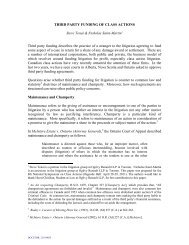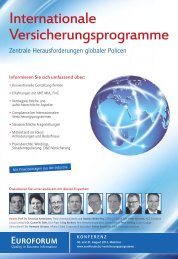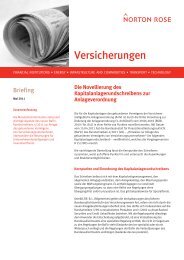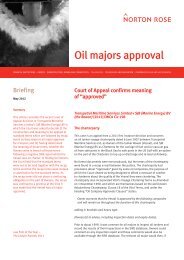The Act Implementing the AIFM Directive - Norton Rose
The Act Implementing the AIFM Directive - Norton Rose
The Act Implementing the AIFM Directive - Norton Rose
You also want an ePaper? Increase the reach of your titles
YUMPU automatically turns print PDFs into web optimized ePapers that Google loves.
Briefing<br />
December 2012<br />
Summary<br />
<strong>The</strong> European Alternative Investment Fund<br />
Manager <strong>Directive</strong> (<strong>AIFM</strong> <strong>Directive</strong>) will<br />
regulate and affect <strong>the</strong> marketing of virtually<br />
all types of funds and <strong>the</strong>ir managers (e.g.<br />
mutual or closed-end, all traditional and<br />
alternative asset classes, all jurisdictions).<br />
This briefing explains <strong>the</strong> legal situation in<br />
Germany on <strong>the</strong> basis of draft legislation<br />
proposed by <strong>the</strong> German Federal Ministry<br />
of Finance dated 30 October 2012. <strong>The</strong><br />
final version is expected to be published<br />
in <strong>the</strong> Federal Law Gazette in spring 2013.<br />
Pursuant to <strong>the</strong> <strong>AIFM</strong> <strong>Directive</strong>, it must be<br />
transposed into national law by 22 July 2013<br />
at <strong>the</strong> latest.<br />
<strong>The</strong> <strong>Act</strong> <strong>Implementing</strong><br />
<strong>the</strong> <strong>AIFM</strong> <strong>Directive</strong><br />
FINANCIAL INSTITUTIONS ⋅ ENERGY ⋅ INFRASTRUCTURE, MINING AND COMMODITIES ⋅ TRANSPORT ⋅ TECHNOLOGY AND INNOVATION ⋅ PHARMACEUTICALS AND LIFE SCIENCES<br />
1 Scope of investment law<br />
It is vitally important for asset managers, distribution channels and investors<br />
to understand clearly <strong>the</strong> scope of <strong>the</strong> future investment legislation<br />
transforming <strong>the</strong> <strong>AIFM</strong> <strong>Directive</strong> 1 and <strong>the</strong> (Consultation Draft of <strong>the</strong>) <strong>Act</strong><br />
<strong>Implementing</strong> <strong>the</strong> <strong>AIFM</strong> <strong>Directive</strong>. 2 In addition to severe sanctions which may<br />
be imposed by <strong>the</strong> Federal Financial Supervisory Authority (Bundesanstalt für<br />
Finanzdienstleistungsaufsicht – BaFin), potentially affecting <strong>the</strong> reputations<br />
of parties subject to <strong>the</strong> <strong>AIFM</strong> <strong>Directive</strong>, its impact may involve claims for civil<br />
law damages, tax consequences and, in exceptional cases, even criminal<br />
penalties. Moreover, in future it will be more difficult to identify scenarios<br />
falling outside <strong>the</strong> scope of <strong>the</strong> investment legislation because <strong>the</strong> existing<br />
fund definition in <strong>the</strong> German Investment <strong>Act</strong> (Investmentgesetz – InvG) −<br />
which, at <strong>the</strong> fundamental level, has a wide scope but, in its more detailed<br />
application, is strictly limited by additional formal criteria − will be replaced<br />
by a purely substance-over-form approach (<strong>the</strong> so-called “material fund<br />
definition”) under <strong>the</strong> Capital Investment Code (Kapitalanlagegesetzbuch –<br />
KAGB). 3 Such a definition had already been used before 2004, but even at<br />
that time, had caused significant difficulties in terms of its application.<br />
In what follows, both categories − <strong>the</strong> formal and <strong>the</strong> material fund definition<br />
(cf. 1.1) − are described as such. Ramifications of <strong>the</strong> new material fund<br />
definition under <strong>the</strong> KAGB (cf. 1.2) and its exceptions are explained in detail<br />
(cf. 1.3). Its effects on practically relevant scenarios are examined (cf. 1.4)<br />
and <strong>the</strong> determinants for future structuring are outlined (cf. 1.5).<br />
1 <strong>Directive</strong> 2011/61/EU of <strong>the</strong> European Parliament and of <strong>the</strong> Council of 8 June 2011 on Alternative Investment Fund<br />
Managers and amending <strong>Directive</strong>s 2003/41/EC and 2009/65/EC and Regulations (EC) No. 1060/2009 und (EU) No.<br />
1095/2010, Official Journal of <strong>the</strong> European Union L 174/1.<br />
2 Consultation Draft of an <strong>Act</strong> implementing <strong>Directive</strong> 2011/61/EC on Alternative Investment Fund Managers, (<strong>AIFM</strong>-<br />
Umsetzungsgesetz – <strong>AIFM</strong>-UmsG) as of 30 October 2012.<br />
3 <strong>The</strong> Capital Investment Code (Kapitalanlagegesetzbuch) (hereinafter “Capital Investment Code” or “KAGB-E”) is<br />
published as Art. 1 of <strong>the</strong> Draft Bill.
<strong>The</strong> <strong>Act</strong> <strong>Implementing</strong> <strong>the</strong> <strong>AIFM</strong> <strong>Directive</strong><br />
02 <strong>Norton</strong> <strong>Rose</strong> December 2012<br />
1.1 Formal and material fund definitions and <strong>the</strong>ir respective backgrounds<br />
Under German law, <strong>the</strong>re is no long-term consistency as regards <strong>the</strong> definitions that apply in<br />
<strong>the</strong> investment sector. Ra<strong>the</strong>r, <strong>the</strong> fund definition applicable at a particular time corresponds<br />
with <strong>the</strong> <strong>the</strong>n prevailing regulatory doctrine. In times of strict regulation, <strong>the</strong> material fund<br />
definition tends to prevail, while in times of less stringent regulation <strong>the</strong> formal definition<br />
applies:<br />
• By applying a substance-over-form approach, <strong>the</strong> material fund definition aims at avoiding<br />
all actual or alleged attempts to circumvent <strong>the</strong> law to <strong>the</strong> disadvantage of investors.<br />
• <strong>The</strong> purpose of <strong>the</strong> formal fund definition, on <strong>the</strong> o<strong>the</strong>r hand, is to ensure legal certainty,<br />
leaving it to <strong>the</strong> discretion of product providers and investors to decide whe<strong>the</strong>r or not to<br />
put <strong>the</strong>mselves within <strong>the</strong> scope of investment regulatory law.<br />
Hence, in view of <strong>the</strong> ongoing global financial crisis, <strong>the</strong> introduction of a material fund<br />
definition which is prescribed by <strong>the</strong> EU <strong>Directive</strong> and, thus, beyond <strong>the</strong> control of <strong>the</strong><br />
German legislator, is not surprising.<br />
Until 2003, a purely material fund definition had existed under <strong>the</strong> former Foreign Investment<br />
<strong>Act</strong> (Auslandinvestmentgesetz – AIG). <strong>The</strong> purpose of <strong>the</strong> material fund definition was to<br />
capture as many collective investment scenarios as possible, despite <strong>the</strong> high complexity<br />
of investment products existing outside Germany, for <strong>the</strong> purpose of investor protection<br />
and to thwart any attempts to circumvent <strong>the</strong> law. Also <strong>the</strong> Investment Modernisation <strong>Act</strong><br />
of 2004 had initially applied a material fund definition. <strong>The</strong> current fund definition has<br />
been applicable since <strong>the</strong> end of 2007, when <strong>the</strong> <strong>Act</strong> Amending <strong>the</strong> German Investment <strong>Act</strong><br />
(Investmentänderungsgesetz – InvÄndG) added formal conditions to <strong>the</strong> fund definition.<br />
Under <strong>the</strong> current law, <strong>the</strong> fund definition comprises a material definition, which forms its<br />
basis, and formal restriction criteria overlaying and limiting it. <strong>The</strong> reason that was given for<br />
this change was to limit <strong>the</strong> scope of <strong>the</strong> InvG to open-ended funds or funds that are subject<br />
to investment supervision in <strong>the</strong>ir home state. 4 This has provided <strong>the</strong> investment sector with<br />
considerable legal certainty and has proved successful in practice.<br />
Following <strong>the</strong> financial crisis, <strong>the</strong> consultation draft of <strong>the</strong> Draft Bill focuses on (alleged)<br />
investor protection and aims to reach <strong>the</strong> widest scope of application possible by prescribing<br />
a material fund definition: 5<br />
“... <strong>the</strong> Capital Investment Code uses a material investment fund definition in line<br />
with <strong>the</strong> requirements of <strong>the</strong> <strong>AIFM</strong> <strong>Directive</strong>. This means that any collective investment<br />
undertaking that collects capital from a number of investors with a view to investing<br />
that capital for <strong>the</strong> benefit of those investors in accordance with a defined investment<br />
strategy qualifies ei<strong>the</strong>r as an undertaking for collective investment in transferable<br />
securities (UCITS) or as an alternative investment fund (AIF) and, accordingly, must meet<br />
<strong>the</strong> requirements under ei<strong>the</strong>r <strong>the</strong> UCITS <strong>Directive</strong> or <strong>the</strong> <strong>AIFM</strong> <strong>Directive</strong> and, thus, also<br />
<strong>the</strong> requirements of this <strong>Act</strong>. A fund that does not meet <strong>the</strong> respective requirements is<br />
unlawful and constitutes prohibited investment business.”<br />
4 Cf. printed paper of Federal Parliament 16/5576, p. 56.<br />
5 Draft Bill, p. 321.
In line with <strong>the</strong> above objective, <strong>the</strong> term “investment asset pool” (Investmentvermögen) is<br />
introduced as a new generic term and is legally defined in section 1 sub-section 1 sentence 1<br />
KAGB-E as follows:<br />
“any collective investment undertaking o<strong>the</strong>r than an operationally active enterprise<br />
outside <strong>the</strong> financial sector that collects capital from a number of investors with a view<br />
to investing that capital for <strong>the</strong> benefit of those investors in accordance with a defined<br />
investment strategy.”<br />
In section 1 sub-section 1 sentence 2 KAGB-E, undertakings for collective investment in<br />
transferable securities (UCITS) and alternative investment funds (AIFs) are defined as <strong>the</strong><br />
two sub-categories of investment asset pools. As UCITS funds are strongly formalised and,<br />
by definition, cannot come into existence if not established by a licensed fund management<br />
company, <strong>the</strong> material investment definition will mainly affect AIFs. Due to <strong>the</strong> definition’s<br />
wide scope, many scenarios involving asset management products may, in future, qualify<br />
as AIFs, subjecting <strong>the</strong>m and <strong>the</strong>ir respective managers – <strong>the</strong> <strong>AIFM</strong>s – to supervision under<br />
<strong>the</strong> KAGB-E. If (possibly by reason of an error) such a situation is not identified, it may have<br />
drastic consequences for managers, distribution channels and investors.<br />
1.2 Fund definition and <strong>the</strong> scope of <strong>the</strong> KAGB-E<br />
1.2.1 Interpretation of <strong>the</strong> law<br />
<strong>The</strong> correct approach to <strong>the</strong> interpretation of <strong>the</strong> law is of particular importance, as <strong>the</strong> material<br />
fund definition in section 1 sub-section 1 sentence 1 KAGB-E is based on only very few criteria<br />
that are not clearly distinguished from each o<strong>the</strong>r. <strong>The</strong> relevant parts of <strong>the</strong> definition are:<br />
i. a collective vehicle (collective investment undertaking)<br />
ii. that collects money<br />
iii. from a number of investors<br />
iv. with a defined investment strategy, and<br />
v. in doing so, acts for <strong>the</strong> investors’ benefit<br />
vi. unless <strong>the</strong> vehicle is an operationally active enterprise outside <strong>the</strong> financial sector.<br />
Except for <strong>the</strong> definition of “a number of investors” in section 1 sub-section 1 sentence 3<br />
KAGB-E, <strong>the</strong> above criteria are nei<strong>the</strong>r described in more detail nor fur<strong>the</strong>r specified in any<br />
o<strong>the</strong>r way. Also, <strong>the</strong> legislative notes (Gesetzesbegründung) to <strong>the</strong> Draft Bill do not contain<br />
information beyond <strong>the</strong> statement that <strong>the</strong> widest possible scope of application should be<br />
created: 6<br />
“Sub-section 1 defines <strong>the</strong> term “investment asset pool” as <strong>the</strong> generic term for all funds<br />
irrespective of <strong>the</strong>ir legal form and irrespective as to whe<strong>the</strong>r <strong>the</strong>y are open-ended or closedended<br />
funds. Thus, investment asset pools comprise both undertakings for collective<br />
investment in transferable securities (UCITS) and alternative investment funds (AIFs).<br />
<strong>The</strong> definition includes domestic UCITS and EU-UCITS as well as domestic AIFs, EU-AIFs<br />
and foreign AIFs.”<br />
6 Draft Bill, substantiation to section 1 sub-section 1, p. 362.<br />
<strong>The</strong> <strong>Act</strong> <strong>Implementing</strong> <strong>the</strong> <strong>AIFM</strong> <strong>Directive</strong><br />
<strong>Norton</strong> <strong>Rose</strong> December 2012 03
<strong>The</strong> <strong>Act</strong> <strong>Implementing</strong> <strong>the</strong> <strong>AIFM</strong> <strong>Directive</strong><br />
04 <strong>Norton</strong> <strong>Rose</strong> December 2012<br />
In <strong>the</strong> case of laws that implement a European directive, <strong>the</strong> focus is on a European lawcompliant<br />
interpretation. Thus, statements contained in <strong>the</strong> discussion paper of ESMA 7 dated<br />
23 February 2012 “Key concepts of <strong>the</strong> Alternative Investment Fund Managers <strong>Directive</strong> and<br />
types of <strong>AIFM</strong>” (hereinafter referred to as “Discussion Paper”) are of particular importance.<br />
A purely national issue impacts massively on <strong>the</strong> interpretation of <strong>the</strong> scope of <strong>the</strong> KAGB-E<br />
and <strong>the</strong> fund definition. According to section 307 no. 1 KAGB-E, anyone who performs <strong>the</strong><br />
business of a capital management company as specified in section 20 sub-section 1 KAGB-E<br />
without holding a licence is punishable. Even AIF capital management companies that<br />
manage small special AIFs and conduct <strong>the</strong>ir business without being registered are subject<br />
to punishment according to section 307 no. 2 KAGB-E. Section 17 sub-section 1 KAGB-E<br />
provides that capital management companies are domestic undertakings whose business is<br />
aimed at, amongst o<strong>the</strong>r things, managing domestic investment asset pools. Consequently,<br />
whe<strong>the</strong>r or not an offence is committed is directly determined by <strong>the</strong> fund definition.<br />
According to <strong>the</strong> principle no penalty without a law of Article 103 sub-section 2 of <strong>the</strong> German<br />
Constitution (Grundgesetz – GG), an individual must be made sufficiently aware whe<strong>the</strong>r<br />
and which behaviour incurs criminal liability. This means that, for constitutional reasons, <strong>the</strong><br />
investment fund definition is to be interpreted narrowly. <strong>The</strong> constitutional principle takes<br />
priority over <strong>the</strong> will of <strong>the</strong> national legislator. Fur<strong>the</strong>rmore, a Community law-compliant<br />
interpretation reaches its limits here, as <strong>the</strong> <strong>AIFM</strong> <strong>Directive</strong>, even though not self-executing<br />
but mandatorily requiring transposition into national law, would be superseded by Article<br />
103 sub-section 2 GG. Hence, a broad interpretation of <strong>the</strong> fund definition is not appropriate<br />
where criminal liability would be no longer sufficiently foreseeable.<br />
<strong>The</strong> aforementioned considerations drive <strong>the</strong> interpretation and definition of an investment<br />
asset pool (Investmentvermögen).<br />
1.2.2 Criterion: collective investment undertaking<br />
<strong>The</strong> first criterion “collective investment undertaking” is not defined in <strong>the</strong> <strong>AIFM</strong> <strong>Directive</strong>.<br />
<strong>The</strong>se words appear to be a reference to <strong>the</strong> UCITS <strong>Directive</strong> 8 where <strong>the</strong> term is also used, but<br />
not specified. <strong>The</strong> term may have to be understood in <strong>the</strong> sense of a collective investment<br />
vehicle. <strong>The</strong> following criteria are stated in clause 28 of <strong>the</strong> Discussion Paper:<br />
“An AIF for <strong>the</strong> purposes of <strong>the</strong> Article 4 must be a collective investment undertaking<br />
which pools toge<strong>the</strong>r capital raised from investors. A collective investment undertaking<br />
should have <strong>the</strong> purpose of generating a return for its investors through <strong>the</strong> sale of its<br />
investments as opposed to an entity acting for its own account and whose purpose is<br />
to manage <strong>the</strong> underlying assets with a view to generating value during <strong>the</strong> life of <strong>the</strong><br />
undertaking.”<br />
<strong>The</strong> above understanding refers to a form of organisation which allows <strong>the</strong> creation of a pool<br />
of assets with <strong>the</strong> possibility to allocate such assets to several parties involved. Hence, it<br />
serves, on <strong>the</strong> one hand, as differentiation from individual portfolio management and trust<br />
situations, where no joint asset pool is created but where an investor grants an individual<br />
authorisation, and, on <strong>the</strong> o<strong>the</strong>r hand, as differentiation from own profit-making situations.<br />
<strong>The</strong> latter alternative is closely related to, and discussed in, <strong>the</strong> paragraph on holding companies. 9<br />
7 http://www.esma.europa.eu/system/files/2012-117.pdf.<br />
8 <strong>Directive</strong> 2009/65/EC of <strong>the</strong> European Parliament and of <strong>the</strong> Council of 13 July 2009 on <strong>the</strong> coordination of laws, regulations and administrative<br />
provisions relating to undertakings for collective investment in transferable securities (UCITS).<br />
9 Cf. clause 1.3.1. below.
Ano<strong>the</strong>r aspect of <strong>the</strong> fund definition, i.e. that investors cannot directly access or control <strong>the</strong><br />
assets of <strong>the</strong> fund, is stated in clauses 33 and 34 of <strong>the</strong> Discussion Paper.<br />
Accordingly, a managed account does not qualify as a collective investment undertaking as it<br />
lacks <strong>the</strong> element of collectivity and <strong>the</strong> holder – in addition to <strong>the</strong> manager of <strong>the</strong> account –<br />
retains or, in any event, may resume its power of disposal. This would also apply if a group of<br />
investors opened a joint account or securities custody account and an asset manager was<br />
granted authority with respect to <strong>the</strong> account. This will mainly be <strong>the</strong> case if <strong>the</strong> portfolio<br />
management is outsourced to an asset manager. Ra<strong>the</strong>r than <strong>the</strong> asset manager level, <strong>the</strong><br />
collective investment undertaking is only created at <strong>the</strong> level of <strong>the</strong> outsourcing fund. This<br />
opinion is confirmed by section 36 sub-section 1 no. 3 KAGB-E, according to which an outsourced<br />
provider requires a licence for individual asset management or financial portfolio management.<br />
1.2.3 Criterion: capital raising<br />
<strong>The</strong> wording of <strong>the</strong> criterion “capital raising” requires an activity on part of <strong>the</strong> investment<br />
asset pool. This means that processes of a purely passive nature are excluded from its scope.<br />
Hence, if several persons come toge<strong>the</strong>r and actively pool money, this can conceptually no<br />
longer be considered as “capital raising”.<br />
<strong>The</strong> Discussion Paper also picks up ano<strong>the</strong>r aspect by pointing out that any capital raising<br />
which is not intended to deliver an investment return or profit should not be considered<br />
an AIF, because <strong>the</strong> concept of capital raising has a commercial component. <strong>The</strong> example<br />
scenario given in <strong>the</strong> Discussion Paper is that a group of householders purchases a piece of<br />
neighbouring land to use it as a common area.<br />
1.2.4 Criterion: number of investors<br />
As regards <strong>the</strong> criterion “number of investors”, section 1 sub-section 1 sentence 3 KAGB-E<br />
states that this criterion is met,<br />
“if <strong>the</strong> investment conditions, <strong>the</strong> articles of association or <strong>the</strong> instrument of<br />
incorporation of <strong>the</strong> collective investment undertaking do not limit <strong>the</strong> number of<br />
possible investors to one single investor.”<br />
<strong>The</strong> <strong>Act</strong> <strong>Implementing</strong> <strong>the</strong> <strong>AIFM</strong> <strong>Directive</strong><br />
<strong>Act</strong>ually, <strong>the</strong> same criterion as <strong>the</strong> requirement of a collective vehicle is referred to here.<br />
Where a number of investors is conceptually excluded, only individual management can exist.<br />
In particular, wholly-owned group companies are thus exempt from <strong>the</strong> scope of <strong>the</strong> KAGB-E.<br />
However, in cases o<strong>the</strong>r than <strong>the</strong> clear cases of individuals or legal persons, <strong>the</strong> question of<br />
<strong>the</strong> definition of “investor” arises. In view of <strong>the</strong> fact that <strong>the</strong> KAGB-E’s purpose is to cover<br />
only collective investment situations, <strong>the</strong> relevant criterion is whe<strong>the</strong>r <strong>the</strong> single investor<br />
acts as a single legal entity. This is affirmed in cases of joint ownership – both with regard to<br />
commercial partnerships and civil law partnerships.<br />
But if a trustee acts as intermediary for several investors, <strong>the</strong> criterion of <strong>the</strong> single investor<br />
is not fulfilled. Clause 29 of <strong>the</strong> Discussion Paper describes a case where a representative<br />
acts on behalf of a number of investors. This is relevant, in particular, in <strong>the</strong> case of a trustee<br />
acting as limited partner – a structure which is commonly used for closed-ended funds.<br />
Formally, a trustee who acts as limited partner is a single investor. But since, economically,<br />
<strong>the</strong> trustee is not to carry any rewards or risks itself, <strong>the</strong> Discussion Paper looks through <strong>the</strong><br />
trustee to <strong>the</strong> investors.<br />
<strong>Norton</strong> <strong>Rose</strong> December 2012 05
<strong>The</strong> <strong>Act</strong> <strong>Implementing</strong> <strong>the</strong> <strong>AIFM</strong> <strong>Directive</strong><br />
06 <strong>Norton</strong> <strong>Rose</strong> December 2012<br />
Equally, a co-ownership by fractional shares presumably does not fulfil <strong>the</strong> criterion of a<br />
single investor. Accordingly, more than one investor should exist. However, a clear distinction<br />
is to be made here. If a co-ownership by fractional shares acts as investor with regard to an<br />
undertaking, more than one investor exists. But whe<strong>the</strong>r a co-ownership by fractional shares<br />
itself may be classified as an AIF is an entirely different issue. This cannot be affirmed,<br />
because, ra<strong>the</strong>r than being a collective vehicle, <strong>the</strong> asset manager acts for each individual<br />
co-owner directly.<br />
1.2.5 Defined investment policy<br />
As ano<strong>the</strong>r criterion, an investment asset pool is characterised by its compliance with is<br />
a defined investment policy. A collective investment vehicle requires that an investment<br />
strategy be followed. On page 11 of <strong>the</strong> Discussion Paper, <strong>the</strong> criterion “defined investment<br />
policy” is interpreted to <strong>the</strong> effect that <strong>the</strong> following prerequisites are to be met:<br />
• <strong>the</strong> investment policy is to be fixed, at <strong>the</strong> latest, by <strong>the</strong> time an investor makes a binding<br />
commitment<br />
• <strong>the</strong> investment policy is incorporated in <strong>the</strong> constitutional documents<br />
• <strong>the</strong> investment strategy forms part of <strong>the</strong> contractual relationship between <strong>the</strong> vehicle and<br />
<strong>the</strong> investor<br />
• determination of investment guidelines (asset categories, geographical regions, leverage,<br />
holding periods, risk diversification) that determine more precise criteria than <strong>the</strong> ones<br />
followed by an operating company pursuing a business strategy<br />
• disclosure of <strong>the</strong> investment strategy to <strong>the</strong> investors<br />
• disclosure and consent requirements in case of changes to <strong>the</strong> investment strategy.<br />
<strong>The</strong> Discussion Paper does not specify whe<strong>the</strong>r all of <strong>the</strong> above prerequisites have to be met.<br />
Instead, it must be assumed that an overall view is presented here and compliance has to be<br />
examined on <strong>the</strong> facts in individual cases.<br />
Ano<strong>the</strong>r aspect of <strong>the</strong> criterion “defined investment policy” is <strong>the</strong> distinction between<br />
investment and non-investment strategies. <strong>The</strong> scope of investment law can only apply if<br />
<strong>the</strong> purpose of <strong>the</strong> collective vehicle is closely related to an investment purpose. Investment<br />
purpose means <strong>the</strong> purchase and passive holding of assets. An investment policy does not<br />
exist, however, if <strong>the</strong> purpose is aimed at o<strong>the</strong>r objectives – in particular, production and<br />
services – and if assets are not purchased or only purchased incidentally to serve purposes<br />
o<strong>the</strong>r than <strong>the</strong> mere holding. In a mixed profile situation, <strong>the</strong> focus is relevant. Only if <strong>the</strong><br />
investment purpose has clear priority may a collective investment vehicle be assumed to<br />
exist. <strong>The</strong> question arising in this connection is <strong>the</strong> quantification of priority. A collective<br />
investment vehicle with an investment strategy may only be assumed to exist if at least 90<br />
per cent of <strong>the</strong> overall objective focus is on <strong>the</strong> investment purpose, while non-investment<br />
purposes are irrelevant in comparison. For example, a construction project development<br />
company, which, in order to add value to project development, also acquires real property,<br />
does not qualify as an investment asset pool. <strong>The</strong> same should apply to film funds, provided<br />
<strong>the</strong> objective of <strong>the</strong> fund is to create a new film licence ra<strong>the</strong>r than to acquire one.
<strong>The</strong> <strong>Act</strong> <strong>Implementing</strong> <strong>the</strong> <strong>AIFM</strong> <strong>Directive</strong><br />
1.2.6 Benefit to investors<br />
According to <strong>the</strong> legal definition of section 1 sub-section 1 KAGB-E, a major criterion of<br />
distinction between an investment asset pool and an operating company is investment to <strong>the</strong><br />
investors’ benefit.<br />
However, this criterion poses considerable difficulties, because operating companies also<br />
ultimately intend to create value for <strong>the</strong>ir shareholders – as is evident from <strong>the</strong> well-known<br />
and accepted concept of shareholder value. A conclusion may not be drawn from <strong>the</strong><br />
distribution and reinvestment behaviour ei<strong>the</strong>r, as this is not necessarily different between<br />
funds and operating companies. Both distribution and reinvestment are activities equally<br />
common to funds and operating companies.<br />
In any case, investor’s benefit will not be held to exist if <strong>the</strong> vehicle’s performance does<br />
not correspond with <strong>the</strong> investment instrument’s value. This criterion also involves <strong>the</strong><br />
definition of a unit in an investment asset pool. Although not <strong>the</strong> subject of discussion here,<br />
this definition must also be dealt with as <strong>the</strong>se aspects are closely linked with each o<strong>the</strong>r. If<br />
<strong>the</strong> legal relationship with <strong>the</strong> vehicle does not reflect its performance – i.e. <strong>the</strong> delta factor<br />
significantly deviates from 1 – <strong>the</strong> vehicle does ei<strong>the</strong>r not qualify as an investment asset pool<br />
or <strong>the</strong> legal relationship with <strong>the</strong> vehicle does not qualify as a fund unit:<br />
• If an investor receives compensation for its investment which is independent from <strong>the</strong><br />
vehicle’s performance, <strong>the</strong> “investment” is a debt instrument. Here, it is irrelevant from <strong>the</strong><br />
investor’s point of view whe<strong>the</strong>r <strong>the</strong> vehicle qualifies as an investment asset pool or not, as<br />
<strong>the</strong> investor does not hold any shares in it.<br />
• If <strong>the</strong> investor receives a multiple of <strong>the</strong> vehicle’s performance, it does not qualify as an<br />
investment asset pool ei<strong>the</strong>r; fur<strong>the</strong>r or alternatively, <strong>the</strong> instrument does not qualify as a<br />
fund unit, but is to be attributed to <strong>the</strong> gambling and betting sector (and in such a case,<br />
enforceability under civil law depends on o<strong>the</strong>r factors).<br />
1.2.7 No operationally active enterprise outside <strong>the</strong> financial sector<br />
In light of <strong>the</strong> vague definition of an investment pool, <strong>the</strong> legislator acknowledges that <strong>the</strong><br />
definition could extend to numerous scenarios clearly outside <strong>the</strong> focus of <strong>the</strong> <strong>AIFM</strong> <strong>Directive</strong>.<br />
<strong>The</strong>refore, <strong>the</strong> legislator has introduced a carve-out for operationally active enterprises<br />
(operativ tätige Unternehmen) outside <strong>the</strong> financial sector (Finanzsektor). <strong>The</strong> basic idea is<br />
that a vehicle allocating a relevant percentage of its resources to <strong>the</strong> production of goods<br />
should not be construed as an investment pool.<br />
However, apart from this basic proposition, <strong>the</strong> carve-out is difficult to interpret since <strong>the</strong>re is<br />
nei<strong>the</strong>r a common understanding of an operationally active enterprise nor a specification for<br />
a financial sector.<br />
By way of example, if a sponsor establishes a vehicle generating value by <strong>the</strong> acquisition and<br />
refurbishment of a property in order to generate a capital gain upon disposal, such scenario<br />
should benefit from <strong>the</strong> carve-out. Since <strong>the</strong> vehicle will provide refurbishment services, it<br />
should be seen as operationally active.<br />
<strong>Norton</strong> <strong>Rose</strong> December 2012 07
<strong>The</strong> <strong>Act</strong> <strong>Implementing</strong> <strong>the</strong> <strong>AIFM</strong> <strong>Directive</strong><br />
08 <strong>Norton</strong> <strong>Rose</strong> December 2012<br />
1.3 Exemptions from <strong>the</strong> fund definition<br />
<strong>The</strong> <strong>AIFM</strong> <strong>Directive</strong> and <strong>the</strong> KAGB-E exclude a number of enterprises which are not considered<br />
to require supervision, or which are regulated in o<strong>the</strong>r ways, from <strong>the</strong> scope of <strong>the</strong> fund<br />
(manager) definition. <strong>The</strong> categories that are relevant in practice are discussed below.<br />
1.3.1 Investment firms<br />
Section 2 sub-section 2 KAGB-E excludes investment firms and credit institutions from <strong>the</strong><br />
scope of capital management companies:<br />
“Investment firms authorised under <strong>Directive</strong> 2004/39/EC 10 and credit institutions<br />
authorised under <strong>Directive</strong> 2006/48/EC 11 are not obliged to obtain a licence under this<br />
<strong>Act</strong> to render investment services, such as individual portfolio management services to<br />
AIFs.”<br />
In principle, this provision has only a clarifying purpose, because due to <strong>the</strong> absence of a<br />
collective investment character, <strong>the</strong> individual portfolio management does not fall within <strong>the</strong><br />
scope of <strong>the</strong> <strong>AIFM</strong> <strong>Directive</strong> and <strong>the</strong> KAGB-E.<br />
1.3.2 Family offices<br />
While <strong>the</strong> wording of <strong>the</strong> KAGB-E does not explicitly refer to family offices, family offices<br />
should be excluded from its scope according to recital 7 of <strong>the</strong> <strong>AIFM</strong> <strong>Directive</strong> and <strong>the</strong><br />
explanation contained in <strong>the</strong> KAGB-E 12 . Interestingly enough, according to recital 7 of <strong>the</strong><br />
<strong>AIFM</strong> <strong>Directive</strong>, family offices are regarded as a sub-category of investment undertakings. This<br />
will normally not be <strong>the</strong> case. However, this consideration should not have an impact on <strong>the</strong><br />
exemption as such.<br />
<strong>The</strong> exemption – to <strong>the</strong> extent a family office can be considered an AIF at all – is justified by<br />
a teleological reduction, because <strong>the</strong> family’s connectivity ought to extinguish <strong>the</strong> conflict<br />
of interest usually existing within a group of unrelated individuals. It is mandatory, however,<br />
that no external fund raising 13 take place outside <strong>the</strong> family. <strong>The</strong> German translation,<br />
which refers to <strong>the</strong> avoidance of “Fremdkapital” (debt) is apparently based on a mistake.<br />
Accordingly, it is “external capital”, ra<strong>the</strong>r than “debt” 14 , that must be excluded.<br />
On this basis, single family offices are clearly exempt from <strong>the</strong> scope of application. In case<br />
of multi family offices, an exemption from <strong>the</strong> scope of application should also be possible if<br />
certain requirements are met. 15<br />
10 MiFID <strong>Directive</strong>, Official Journal of <strong>the</strong> European Union L 145/1 of 30 April 2004.<br />
11 Banking Consolidation <strong>Directive</strong>, Official Journal of <strong>the</strong> European Union L 177/1 of 30 June 2006.<br />
12 Draft Bill, p. 346.<br />
13 <strong>AIFM</strong> <strong>Directive</strong>, English version, Official Journal of <strong>the</strong> European Union, L 174/1, Recital 7 reads as follows ”without raising external capital”,<br />
while <strong>the</strong> German version is translated as “ohne Fremdkapital zu beschaffen” (without raising debt capital).<br />
14 Although <strong>the</strong> translation mistake of <strong>the</strong> <strong>AIFM</strong> <strong>Directive</strong>’s wording has made its way into <strong>the</strong> explanatory comments to KAGB-E, p. 346, it may be<br />
assumed that <strong>the</strong> actually intended content of <strong>the</strong> <strong>Directive</strong> should be transposed, considering that <strong>the</strong> legislator must be presumed to have<br />
intended only to implement <strong>the</strong> <strong>AIFM</strong> <strong>Directive</strong>.<br />
15 For detailed information, cf. Krause/Klebeck, BB 2012, 2063 to be published in August.
<strong>The</strong> <strong>Act</strong> <strong>Implementing</strong> <strong>the</strong> <strong>AIFM</strong> <strong>Directive</strong><br />
1.3.3 Holding companies<br />
Pursuant to section 2 sub-section 1 no. 1 KAGB-E, holding companies do not fall within <strong>the</strong><br />
scope of capital management companies. A holding company is (freely translated)<br />
“a company with shareholdings in one or more o<strong>the</strong>r companies, <strong>the</strong> commercial<br />
purpose of which is to carry out a business strategy or strategies through its<br />
subsidiaries, associated companies or participations in order to contribute to <strong>the</strong>ir longterm<br />
value, and which is ei<strong>the</strong>r<br />
– a company operating on its own account whose shares are admitted to trading on a<br />
regulated market in <strong>the</strong> Union, or<br />
– a company not established for <strong>the</strong> main purpose of generating returns for its investors<br />
by means of divestment of its subsidiaries or associated companies, as evidenced in its<br />
annual report or o<strong>the</strong>r official documents.”<br />
European and German legislators have been confronted with <strong>the</strong> issue of differentiating<br />
between holding companies with widespread interests and fund constellations. This is a<br />
challenge, as <strong>the</strong>re are, at most, only marginal differences between a holding company<br />
and a long-term oriented private equity fund. Both achieve added value through <strong>the</strong><br />
subsidiaries which <strong>the</strong>y control and whose value <strong>the</strong>y wish to increase in <strong>the</strong> long term. A<br />
differentiation from private equity funds is seen in <strong>the</strong> intended exit through <strong>the</strong> proposed<br />
sale of subsidiaries (targets). Indeed, this is a characteristic of private equity funds but it<br />
is not unique. Equally, industrial and financial groups might plan from <strong>the</strong> outset to sell<br />
subsidiaries in case adequate capital gains stand to be made. For this reason, <strong>the</strong> German<br />
legislator has provided for a formalisation to <strong>the</strong> effect that companies which operate for <strong>the</strong>ir<br />
own account and are listed on a regulated market are exempt from <strong>the</strong> scope of <strong>the</strong> KAGB-E.<br />
Accordingly, it is sufficient that <strong>the</strong> annual report and official documents do not contain any<br />
statement to <strong>the</strong> effect that <strong>the</strong> company’s purpose comprises <strong>the</strong> adding of value through<br />
<strong>the</strong> sale of holdings in subsidiaries.<br />
1.3.4 Securitisation<br />
According to section 2 sub-section 1 no. 7 KAGB-E, securitisation vehicles do not qualify as<br />
capital management companies. This is consistent with <strong>the</strong> implementation of recital 8 of<br />
<strong>the</strong> <strong>AIFM</strong> <strong>Directive</strong>. Freely translated, section 1 sub-section 19 number 32 KAGB-E defines<br />
securitisation vehicles as<br />
“companies whose sole purpose is to carry out one or several securitisations within<br />
<strong>the</strong> meaning of Article 1 sub-section 2 of Regulation (EC) No. 24/2009 of <strong>the</strong> European<br />
Central Bank of 19 December 2008 concerning statistics on <strong>the</strong> assets and liabilities of<br />
financial vehicle corporations engaged in securitisation transactions (Official Journal<br />
L 15 of 20 January 2009, p. 1) and to carry out additional activities which are suited to<br />
fulfil this purpose.”<br />
<strong>Norton</strong> <strong>Rose</strong> December 2012 09
<strong>The</strong> <strong>Act</strong> <strong>Implementing</strong> <strong>the</strong> <strong>AIFM</strong> <strong>Directive</strong><br />
Section 1 sub-section 2 of Regulation (EC) No. 24/2009 reads as follows:<br />
“2. ‘securitisation’ means a transaction or scheme whereby an asset or pool of assets is<br />
transferred to an entity that is separate from <strong>the</strong> originator and is created for or serves<br />
<strong>the</strong> purpose of <strong>the</strong> securitisation and/or <strong>the</strong> credit risk of an asset or pool of assets, or<br />
part <strong>the</strong>reof, is transferred to <strong>the</strong> investors in <strong>the</strong> securities, securitisation fund units,<br />
o<strong>the</strong>r debt instruments and/or financial derivatives issued by an entity that is separate<br />
from <strong>the</strong> originator and is created for or serves <strong>the</strong> purpose of <strong>the</strong> securitisation, and:<br />
in case of transfer of credit risk, <strong>the</strong> transfer is achieved by:<br />
– <strong>the</strong> economic transfer of <strong>the</strong> assets being securitised to an entity separate from <strong>the</strong><br />
originator created for or serving <strong>the</strong> purpose of <strong>the</strong> securitisation. This is accomplished<br />
by <strong>the</strong> transfer of ownership of <strong>the</strong> securitised assets from <strong>the</strong> originator or through subparticipation,<br />
or<br />
– <strong>the</strong> use of credit derivatives, guarantees or any similar mechanism;<br />
and<br />
10 <strong>Norton</strong> <strong>Rose</strong> December 2012<br />
where such securities, securitisation fund units, debt instruments and/or financial<br />
derivatives are issued, <strong>the</strong>y do not represent <strong>the</strong> originator’s payment obligations ….“<br />
<strong>The</strong> differentiation between securitisation vehicles and investment funds is particularly<br />
difficult, as both such enterprises are closely connected with each o<strong>the</strong>r. Most striking is <strong>the</strong><br />
overlap in <strong>the</strong> case of Managed Collateralised Debt Obligations (Managed CDOs), whose fund<br />
character had already been hotly debated under <strong>the</strong> former AIG. However, this legal issue<br />
does not apply to <strong>the</strong> current situation, as <strong>the</strong> legislator has stipulated a clear exemption.<br />
According to <strong>the</strong> definition contained in <strong>the</strong> Regulation, it is sufficient to transfer <strong>the</strong> asset<br />
pool to a securitisation vehicle to avoid <strong>the</strong> applicability of <strong>the</strong> KAGB-E. However, <strong>the</strong><br />
existence of credit risks (in which case special rules would apply) or a division into tranches<br />
is not required. Thus, managers of Managed CDOs are exempt from <strong>the</strong> definition of an <strong>AIFM</strong>.<br />
1.3.5 Insurances<br />
According to recital 8 of <strong>the</strong> <strong>AIFM</strong> <strong>Directive</strong> and p. 368 of <strong>the</strong> Draft Bill, which, however, is not<br />
reflected in <strong>the</strong> KAGB-E, insurance contracts do not fall within <strong>the</strong> scope of <strong>the</strong> investment<br />
law. This is accounted for in <strong>the</strong> Draft Bill insofar as, in Article 26 amending <strong>the</strong> Insurance<br />
Supervisory <strong>Act</strong> (Versicherungsaufsichtsgesetz − VAG), it provides for cases where an insurer<br />
invests in AIFs for <strong>the</strong> purposes of insurance contracts and, thus, also clarifies that <strong>the</strong><br />
embedding of funds in insurance contracts (an “insurance wrapper”) is not subject to <strong>the</strong><br />
KAGB-E.<br />
1.3.6 Joint ventures<br />
Pursuant to recital 8 of <strong>the</strong> <strong>AIFM</strong> <strong>Directive</strong> and page 368 of <strong>the</strong> Draft Bill, joint ventures are<br />
also excluded from <strong>the</strong> scope of <strong>the</strong> KAGB-E. A definition of <strong>the</strong> term ‘joint venture’, however,<br />
is not provided. In general, a joint venture is defined as <strong>the</strong> systematic cooperation of<br />
two or more parties each of which contributes to <strong>the</strong> achievement of a common objective.<br />
Correspondingly, if several parties come toge<strong>the</strong>r to pursue a common purpose − such as an<br />
investment purpose − <strong>the</strong> KAGB-E does not apply.
1.4 Scenarios<br />
Besides <strong>the</strong> aforementioned explicit exemptions and <strong>the</strong> exemptions which are at least<br />
mentioned in <strong>the</strong> explanatory comments to <strong>the</strong> law, <strong>the</strong>re are fur<strong>the</strong>r scenarios outside <strong>the</strong><br />
scope of <strong>the</strong> KAGB-E.<br />
1.4.1 Structured products<br />
Characteristic to structured products is that an issuer issues a cash instrument in which a<br />
(basic or complex) derivative is embedded. Often − but not necessarily − credit institutions<br />
act as issuers. Since, as a consequence of <strong>the</strong> financial crisis investors are not always<br />
permitted to have a (high) credit exposure to a single credit institution, single purpose<br />
vehicles (SPV) are also frequently used as issuers. Cases where credit institutions act as<br />
issuers obviously do not fall within <strong>the</strong> scope of <strong>the</strong> KAGB-E, as, due to <strong>the</strong>ir operating<br />
activities, credit institutions cannot qualify as an investment asset pool.<br />
Moreover, <strong>the</strong> KAGB-E does not apply to situations where a SPV acquires, for example,<br />
investment fund units, issues structured or hybrid products (delta-1 certificates or<br />
participation rights or certificates) with respect <strong>the</strong>reto, and <strong>the</strong>n provides such investment<br />
fund units to investors as collateral against <strong>the</strong> possibility that <strong>the</strong> SPV fails to duly comply<br />
with its obligations under <strong>the</strong> certificates or o<strong>the</strong>r instruments. However, <strong>the</strong> fact that <strong>the</strong><br />
KAGB-E does not apply to <strong>the</strong>se cases certainly requires a more detailed explanation.<br />
As regards participation rights, <strong>the</strong> legislator has expressly provided for <strong>the</strong> non-applicability<br />
of <strong>the</strong> KAGB-E by amending section 1 sub-section 2 of <strong>the</strong> Capital Investment <strong>Act</strong><br />
(Vermögensanlagegesetz – VermAnlG) by Article 4 of <strong>the</strong> Draft Bill. <strong>The</strong> new wording is as<br />
follows (freely translated and amendments shown in italics):<br />
(2) Capital investments within <strong>the</strong> meaning of this <strong>Act</strong> are:<br />
1 shares granting a participation in <strong>the</strong> profit or loss of an undertaking;<br />
2 shares in a pool of assets held or managed by <strong>the</strong> issuer or a third party in its own<br />
name for <strong>the</strong> account of o<strong>the</strong>rs (trust assets);<br />
3 units in o<strong>the</strong>r closed-ended funds;<br />
4 participation rights; and<br />
5 registered bonds,<br />
<strong>The</strong> <strong>Act</strong> <strong>Implementing</strong> <strong>the</strong> <strong>AIFM</strong> <strong>Directive</strong><br />
which are not represented by securities within <strong>the</strong> meaning of <strong>the</strong> WpPG and not structured<br />
as shares in investment asset pools within <strong>the</strong> meaning of section 1 sub-section 1 KAGB.<br />
On page 559 of <strong>the</strong> Draft Bill, <strong>the</strong> above amendment is explained as follows (freely translated):<br />
“This amendment ensures that <strong>the</strong> Capital Investment <strong>Act</strong> (Vermögensanlagengesetz)<br />
henceforth only applies to capital investments, which are not subject to <strong>the</strong> new<br />
provisions of <strong>the</strong> Capital Investment Code; this may apply, in particular, to participation<br />
rights and registered bonds.”<br />
Thus, it is explicitly stated that, as a general rule, participation rights are not treated as fund<br />
units.<br />
<strong>Norton</strong> <strong>Rose</strong> December 2012 11
<strong>The</strong> <strong>Act</strong> <strong>Implementing</strong> <strong>the</strong> <strong>AIFM</strong> <strong>Directive</strong><br />
12 <strong>Norton</strong> <strong>Rose</strong> December 2012<br />
This position is confirmed also at <strong>the</strong> EU level, as structured products are subject to <strong>the</strong><br />
Packaged Retail Investment Products Regulation (PRIPs Regulation 16 ) and it is, <strong>the</strong>refore, not<br />
considered to extend <strong>the</strong> scope of <strong>the</strong> <strong>AIFM</strong> <strong>Directive</strong>.<br />
<strong>The</strong> non-applicability of <strong>the</strong> KAGB-E to delta-1 certificates and hybrid instruments results from<br />
<strong>the</strong> fact that <strong>the</strong>se instruments do not enable <strong>the</strong> investor to participate fully in <strong>the</strong> vehicle’s<br />
performance, but instead give him <strong>the</strong> status of a creditor. <strong>The</strong>refore, <strong>the</strong>y do not constitute<br />
capital investments for <strong>the</strong> benefit of <strong>the</strong> investor.<br />
<strong>The</strong> future legal environment under <strong>the</strong> KAGB-E is likely to be quite similar to <strong>the</strong> situation<br />
that existed historically between 2004 and 2007 when a material fund definition<br />
applied. At that time, both <strong>the</strong> tax department of <strong>the</strong> Federal Ministry of Finance<br />
(Bundesfinanzministerium) 17 and BaFin 18 issued decrees pursuant to which fund-linked<br />
certificates were not to be construed as fund units.<br />
1.4.2 Issuing entities in <strong>the</strong> context of group financing<br />
Issuing entities, which are often used in <strong>the</strong> context of group financing, do not fall within <strong>the</strong><br />
scope of <strong>the</strong> KAGB-E ei<strong>the</strong>r. <strong>The</strong> issuing entity (which is often ei<strong>the</strong>r a Delaware LLC or Dutch<br />
BV) issues bonds that replicate <strong>the</strong> debt or equity capital performance of <strong>the</strong> domestic parent<br />
company.<br />
In principle, <strong>the</strong> statements made above on structured products apply mutatis mutandis,<br />
because in this situation also, no company shares, but only hybrid instruments, are issued.<br />
1.5 Structural considerations<br />
In view of <strong>the</strong> changing environment, <strong>the</strong> asset management industry will have to decide<br />
whe<strong>the</strong>r to meet <strong>the</strong> requirements of <strong>the</strong> KAGB-E or change to o<strong>the</strong>r forms of capital<br />
investment products. In this context, in particular, <strong>the</strong> following criteria will be relevant:<br />
• administrative expenses and costs incurred due to <strong>the</strong> <strong>AIFM</strong> <strong>Directive</strong> and KAGB-E,<br />
respectively, in particular, <strong>the</strong> costs of <strong>the</strong> mandatory depositary<br />
• treatment of fund units and capital market products under Solvency II, as insurers are <strong>the</strong><br />
most important group of investors and, <strong>the</strong>refore, <strong>the</strong>ir regulation is a decisive factor when<br />
determining <strong>the</strong> structure of investment products<br />
• corporate law issues arising from legal action taken by limited partners if <strong>the</strong>y are<br />
unsatisfied and<br />
• tax treatment of investment products at fund and investor level; <strong>the</strong> tax burden depends on<br />
<strong>the</strong> asset class and <strong>the</strong> investor type and, thus, <strong>the</strong> potential for tax optimisation exists.<br />
16 Proposal for a Regulation of <strong>the</strong> European Parliament and of <strong>the</strong> Council on key information documents for investment products, 2012/0169<br />
(COD), http://ec.europa.eu/internal_market/finservices-retail/docs/investment_products/20120703-proposal_en.pdf.<br />
17 Federal Ministry of Finance, tax guideline on investment taxation, dated 2 June 2005, annotation 9.<br />
18 BaFin, decree on <strong>the</strong> regulatory adoption of <strong>the</strong> tax guideline on investment taxation, dated 22 August 2005.
nortonrose.com<br />
FINANCIAL INSTITUTIONS ⋅ ENERGY ⋅ INFRASTRUCTURE, MINING AND COMMODITIES ⋅ TRANSPORT ⋅ TECHNOLOGY AND INNOVATION ⋅ PHARMACEUTICALS AND LIFE SCIENCES<br />
Contacts<br />
If you would like fur<strong>the</strong>r information<br />
please contact:<br />
Dr. Caroline Herkströter<br />
Partner<br />
Tel +49 (0)69 505096-300<br />
caroline.herkstroeter@nortonrose.com<br />
Dr. Martin Krause<br />
Partner<br />
Tel +49 (0)69 505096-490<br />
martin.krause@nortonrose.com<br />
Dr. Ludger Verfürth<br />
Partner<br />
Tel +49 (0)40 970799-160<br />
ludger.verfuerth@nortonrose.com<br />
<strong>Norton</strong> <strong>Rose</strong><br />
<strong>Norton</strong> <strong>Rose</strong> is a leading international legal practice. With more than 2900 lawyers, we<br />
offer a full business law service to many of <strong>the</strong> world’s pre-eminent financial institutions<br />
and corporations from offices in Europe, Asia, Australia, Canada, Africa, <strong>the</strong> Middle East,<br />
Latin America and Central Asia. We are strong in financial institutions; energy; infrastructure,<br />
mining and commodities; transport; technology and innovation; and pharmaceuticals<br />
and life sciences.<br />
On June 1, 2013 <strong>Norton</strong> <strong>Rose</strong> will join forces with leading U.S. law firm Fulbright & Jaworski<br />
L.L.P. to form <strong>Norton</strong> <strong>Rose</strong> Fulbright. With 3800 lawyers and 54 offices, including 11 in <strong>the</strong><br />
USA, <strong>Norton</strong> <strong>Rose</strong> Fulbright will be one of <strong>the</strong> largest global legal practices, with significant<br />
depth of expertise in <strong>the</strong> world’s leading business and financial centres.<br />
<strong>Norton</strong> <strong>Rose</strong> is <strong>the</strong> business name for <strong>the</strong> international law firm that comprises <strong>Norton</strong> <strong>Rose</strong> LLP, <strong>Norton</strong> <strong>Rose</strong> Australia, <strong>Norton</strong> <strong>Rose</strong> Canada LLP and <strong>Norton</strong> <strong>Rose</strong> South Africa (incorporated as Deneys<br />
Reitz Inc) and <strong>the</strong>ir respective affiliates (“<strong>Norton</strong> <strong>Rose</strong> entity/entities”). <strong>The</strong> purpose of this publication is to provide information as to developments in <strong>the</strong> law. It does not contain a full analysis of<br />
<strong>the</strong> law, nor does it constitute an opinion of <strong>Norton</strong> <strong>Rose</strong> on <strong>the</strong> points of law discussed. You must take specific legal advice on any particular matter which concerns you. If you require any advice<br />
or fur<strong>the</strong>r information, please speak to your usual contact at <strong>Norton</strong> <strong>Rose</strong>. No individual who is a member, partner, shareholder, director, employee or consultant of, in or to any <strong>Norton</strong> <strong>Rose</strong> entity<br />
(whe<strong>the</strong>r or not such individual is described as a “partner”) accepts or assumes responsibility, or has any liability, to any person in respect of this publication. Any reference to a partner or director is<br />
to a member, employee or consultant with equivalent standing and qualifications of, as <strong>the</strong> case may be, <strong>Norton</strong> <strong>Rose</strong> LLP or <strong>Norton</strong> <strong>Rose</strong> Australia or <strong>Norton</strong> <strong>Rose</strong> Canada LLP or <strong>Norton</strong> <strong>Rose</strong> South<br />
Africa (incorporated as Deneys Reitz Inc) or of one of <strong>the</strong>ir respective affiliates.<br />
© <strong>Norton</strong> <strong>Rose</strong> LLP NR14304 12/12 (UK) Extracts may be copied provided <strong>the</strong>ir source is acknowledged.













